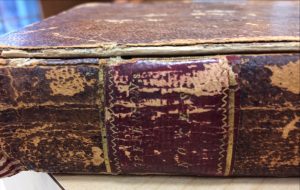
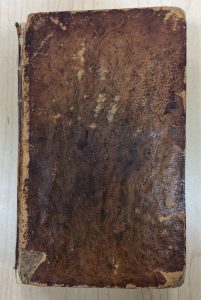
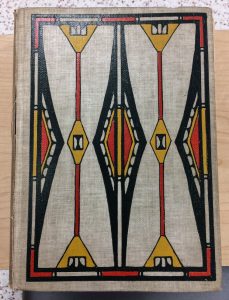
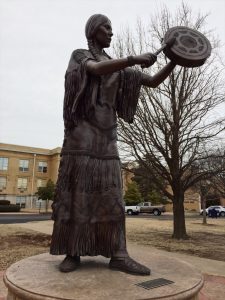
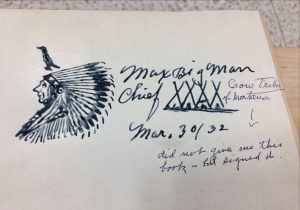
Course site for The Social Life of Books – A COPLACDigital course
For the collective four years I have attended the University of Science and Arts of Oklahoma, I haven’t spent much time in our library. Now, I’m asking myself “why?” I… Read More





Gene Hyde and Collin Reeve are the two lovely gentleman that work in the UNC Asheville Special Collections. Both of them were more than happy to talk about the books in the Special Collections and expressed interest in being kept in the loop about what this course does. Their enthusiasm made this assignment very enjoyable […]
“She cooked her green beans, freshly snapped, with a piece of fatback in a Club Aluminum pot, and she made her biscuits with buttermilk and lard, baking them on a dark pan that had to be at least 50 years old.”
Apparently, any biscuits sent home never made it out of the twenty foot driveway. This coupled with Allison’s love of reading manifested into research about cookbooks. From there, Allison asserts that her collecting grew into “an obsession to own every cookbook printed”. She gave the collection to UNC Asheville so that other scholars could benefit from having the cookbooks to research and so that Dr. Locklear could continue her work on looking at food culture through cookbook literature. All in all, it was a very informative and interesting way to be introduced to the Special Collections.For the first assignment of the semester, I had to go to my campus’ library and do a little research on our archives. I found that the oldest full text in the collection is the Nuremberg Chronicle, even though we do have a few pages of the Gutenberg Bible. The Nuremberg Chronicle was published in 1493 … Continue reading “Nolan A. Moore III Collection at MSU”
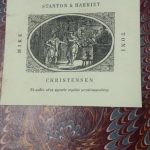
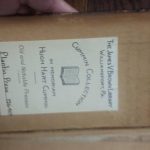
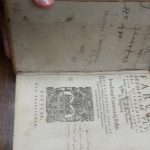
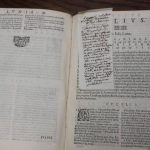
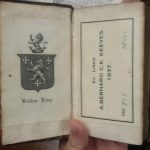
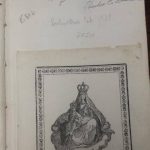
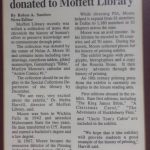
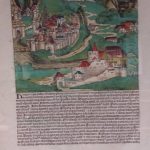
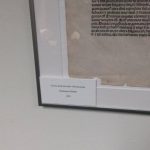
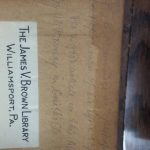
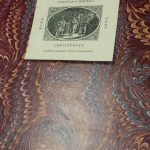 For the first assignment of the semester, I had to go to my campus’ library and do a little research on our archives. I found that the oldest full text in the collection is the Nuremberg Chronicle, even though we do have a few pages of the Gutenberg Bible. The Nuremberg Chronicle was published in 1493 by Anton Koberger. One of the interesting things about this text is the pictures. On a lot of the pages, custom wood blocks were inked and pressed onto the pages and then colored in by someone the owner hired. Five hundred years later and the pictures are still as bright and vivid as I’m sure they were when the text was published.
All of the books in the collection showed some evidence of reader use, but one that stood out to me was Aesop’s Fables. It was covered in writing and even had a little bookmark that had notes all over it. This tells us that the Fables were beloved and studied just as much then as they are today.
Being at a smaller university, MSU just has the one collection. Although it’s not huge, the collection has everything from pieces of Sumerian clay tablets to newspaper clippings of the Emancipation Proclamation and Pearl Harbor to original comic books. The one thing the collection has in common is that it was all donated by one man, Nolan A. Moore. He travelled the world to find all these texts and being a man from Wichita Falls, TX, he decided to donate all of it to our school. For more information about the collection, click here.
For the first assignment of the semester, I had to go to my campus’ library and do a little research on our archives. I found that the oldest full text in the collection is the Nuremberg Chronicle, even though we do have a few pages of the Gutenberg Bible. The Nuremberg Chronicle was published in 1493 by Anton Koberger. One of the interesting things about this text is the pictures. On a lot of the pages, custom wood blocks were inked and pressed onto the pages and then colored in by someone the owner hired. Five hundred years later and the pictures are still as bright and vivid as I’m sure they were when the text was published.
All of the books in the collection showed some evidence of reader use, but one that stood out to me was Aesop’s Fables. It was covered in writing and even had a little bookmark that had notes all over it. This tells us that the Fables were beloved and studied just as much then as they are today.
Being at a smaller university, MSU just has the one collection. Although it’s not huge, the collection has everything from pieces of Sumerian clay tablets to newspaper clippings of the Emancipation Proclamation and Pearl Harbor to original comic books. The one thing the collection has in common is that it was all donated by one man, Nolan A. Moore. He travelled the world to find all these texts and being a man from Wichita Falls, TX, he decided to donate all of it to our school. For more information about the collection, click here. On January 11, 2017, Brittany Williams and I met with Midwestern State University’s archivist. We soon realized we had this entire assignment handed to us in a single collection. With MSU being a smaller university, the entirety of our rare books section is comprised of a single collection created and owned by Nolan Moore. He […]
On January 11, 2017, Brittany Williams and I met with Midwestern State University’s archivist. We soon realized we had this entire assignment handed to us in a single collection. With MSU being a smaller university, the entirety of our rare books section is comprised of a single collection created and owned by Nolan Moore. He traveled the world and most of the United States in search of great works and early evidence of written human communication.
While there were a few leafs from the Gutenberg Bible, the oldest complete book in the collection is the Nuremberg Chronicles, written by Hartmann Schedel and published in 1493 by Anton Koberger. This book was created by a woodcut press. The intricate process that went into producing this beautiful work was my first indication of how important books and records were to the people of this time period. Because the majority of the book is a reconstruction with pictures of the Hebrew Bible and a rough history of the world, it reinforced my preconceived notion that religion dominated the culture of this time period.
Most of the works in the collection were so well preserved that they looked untouched. A small edition of Dante’s Inferno did show a lot of evidence of ownership and marginalia. Most of the pages were annotated in small, cramped ink handwriting that was extremely difficult to read. Because of the amount of writing in the book, I assume it was used for scholastic purposes before Moore collected it.
The collection was donated to MSU by Moore’s family after his death. Nolan Moore and his family were native Wichitans and wanted the collection to go to a smaller liberal arts university. They eventually decided Midwestern State was the best choice. Moore dedicated his life to showing others the significance of human communication and its evolution over time, making that the underlying theme of this collection. From a model of cave drawings and the Rosetta Stone to first editions of comic books, Moore found significance in printed works no matter what their origins or intended and was motivated to share their importance.
https://www.mwsu.edu/library/departments/Nolan-Moore-III/print
Welcome to Social Life of Books Sites. This is your first post. Edit or delete it, then start blogging!
Welcome to Social Life of Books Sites. This is your first post. Edit or delete it, then start blogging!
I, along with fellow Montevallo student Savannah Willard, met with the school archivist to discuss the questions posed to us by Dr. Pauley and Dr. Bankhurst. Despite the fact that I have been interning in our school’s archives for the past semester, many of these questions were not things I’d gotten to explore yet, and […]